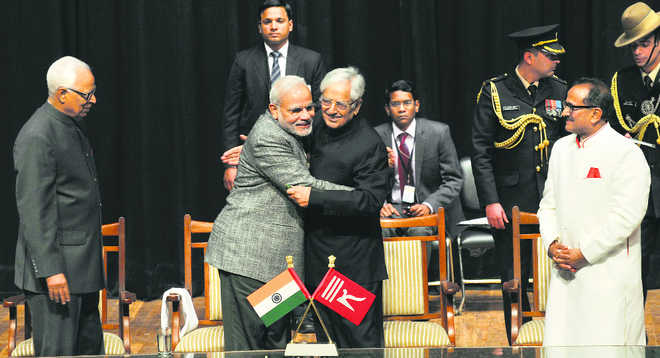By Dr. Shiv Shakti Bakshi
A new history has been created in Jammu & Kashmir. BJP and PDP have come together to form new government in the state. As Mufti Mohammad Sayeed was being sworn in as the new chief minister of Jammu & Kashmir in the presence of Prime Minister Narendra Modi and BJP President Amit Shah, the people of the state were looking forward for a new future and the nation was watching it with newfound hope and confidence. It was the dawn of a new era in Indian politics as this government was seen as an initiative which may bring in long lasting solutions to some of the longstanding problems on the basis of bonds of goodwill and trust between the union and the state governments. It was a fitting tribute to the people of Jammu and Kashmir who had voted so enthusiastically in the assembly elections strengthening democracy and speaking in favour of development and progress.
The people of Jammu & Kashmir had to wait for over two long months to get their government in the state. The results of the assembly elections which were declared on 23rd December 2014 saw a hung assembly in the state with PDP getting 28 seats followed by BJP with 25 seats. The NC and Congress could manage 15 and 12 seats respectively in 87-member legislative assembly of the state. The talks between PDP and BJP continued for around two months and finally as a result of an understanding reached on many crucial issues the government was sworn-in on 1st March 2015. While Mufti Mohammad Sayeed of the PDP was sworn as Chief Minister, Nirmal Singh of BJP took the oath as Deputy Chief Minister. As the Governor NN Vohra administered the oath, 13 MLAs including Sayeed from the PDP and 12 MLAs from BJP and People’s Conference combine were sworn-in as ministers. Sajjad Lone from People’s Conference became a minister from the BJP quota. The government has reiterated its commitment towards development and progress of the state.
The PDP-BJP government which appeared impossible for many political analysts became a reality as both sides worked hard for two months to give shape to their common minimum programme. In the 16-page “Agenda of the Alliance” many crucial issues were addressed and future agenda was worked out. While a status quo was to be maintained on Article 370, the PDP-BJP government promised to examine the need for denotifying disturbed areas with regard to AFSPA. The government is also expected to take measures for sustenance and livelihood of West Pakistani refugees and work out one-time settlements of refugees from Pak-occupied Kashmir in 1947, 1965 and 1971. The governance alliance reached by BJP-PDP seeks to make efforts towards seeking national reconciliation on Jammu and Kashmir.
A section in the media and opposition have criticized BJP for purportedly abandoning its stand on Article 370 which is, in any case, not true. In fact these are the same elements who have been criticizing BJP for its stand on the issue. BJP has never sought to impose its view or forcefully repeal the article but it has always tried to build a political consensus over it. No one should be in confusion that the present arrangement is nothing more than maintenance of status quo on the issue for now and the time is to initiate confidence building measures among the stakeholders so that an amicable solution is found for all longstanding issues in Jammu & Kashmir. The PDP has also shown political maturity over AFPSA and instead of resorting to political rhetoric has shown willingness to act in accordance with the ground realities. The issue of rehabilitation of refugees from West Pakistan is a major achievement also. It will help in applying balm to the long festering wounds. The formation of government in itself is an initiative in the right direction which may go a long way in finding solutions to longstanding problems of the state.
The BJP has come to power for the first time in Jammu & Kashmir. Never before could BJP win so many seats as it was voted overwhelmingly in Jammu region and could win 25 seats to become the second largest party in the state just three seats behind PDP. In the Kashmir valley also BJP made its presence felt for the first time with many candidates contesting elections with full commitment and sincerity. But in the valley PDP was voted by the people helping it to win 28 seats. So it was natural that a government formed by BJP-PDP had the mandate of both Jammu and Kashmir region of the state. The BJP-PDP government therefore represents the aspirations of both the major regions and may work towards development of the people. It is an opportunity for the BJP to work hard among the people and create a niche for the party in the hearts of the people of the Kashmir valley also. The state may develop and prosper only if both the regions come together and recognize the mutual beneficial alliance for development and prosperity. It is time to build bridges and goodwill for a developed state and a stronger and vibrant India.
(The writer is Executive Editor of the BJP mouthpiece Kamal Sandesh and a PhD from JNU in History)
(The views expressed are the author's own and do not necessarily reflect the position of the organisation)

